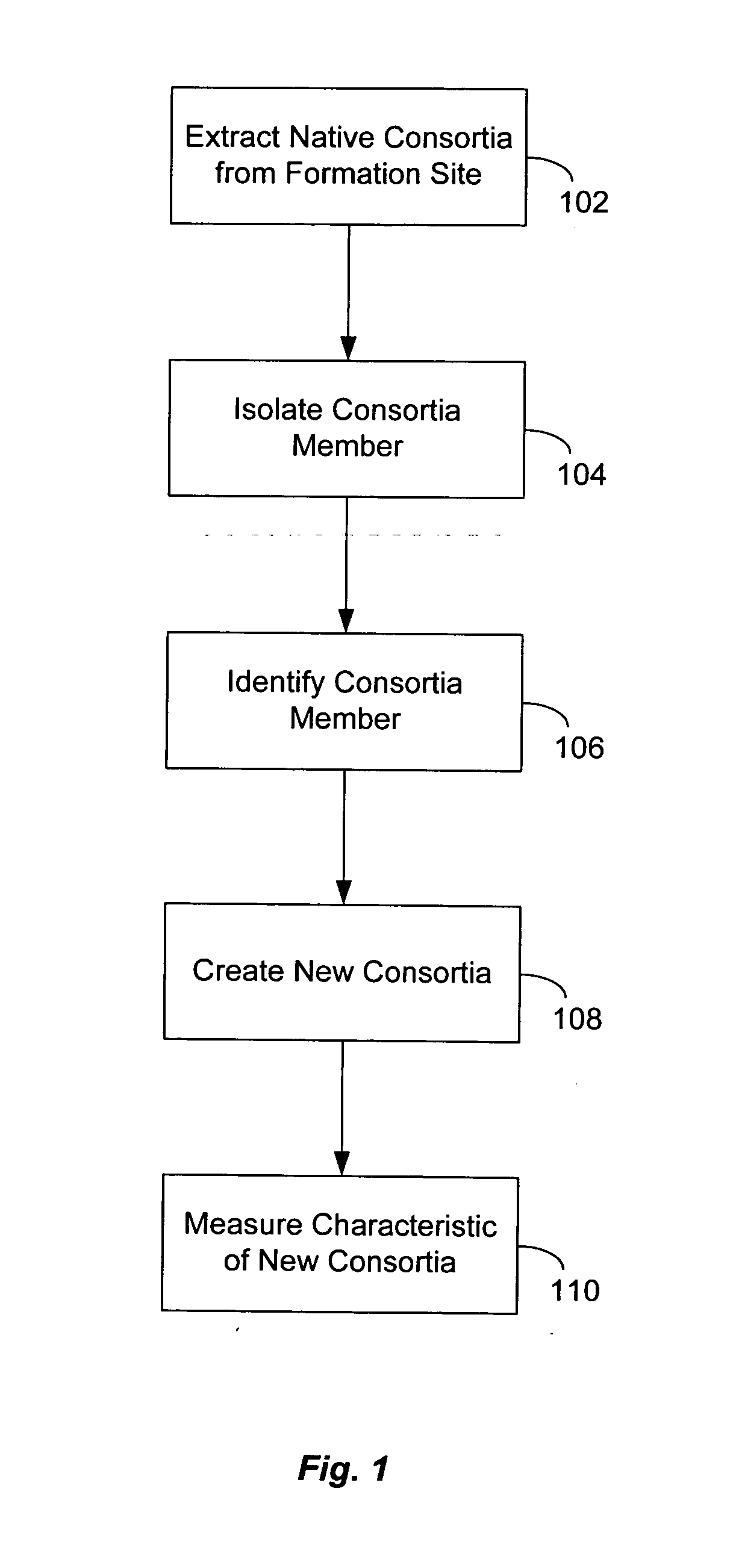Systems and methods for the isolation and identification of microorganisms from hydrocarbon deposits
a technology of hydrocarbon deposits and systems, applied in the field of hydrocarbon deposit isolation, can solve the problems of difficult study in conventional laboratories, most anaerobic microorganisms cannot survive in the oxygen rich atmosphere above ground, etc., and achieve the effect of easy recovery or extraction, and easy recovery or recovery
- Summary
- Abstract
- Description
- Claims
- Application Information
AI Technical Summary
Benefits of technology
Problems solved by technology
Method used
Image
Examples
example 1
Isolation of Microorganisms
[0071] Native anaerobic microorganisms have been collected from a variety of sub-surface formations, and studied in a controlled, low-oxygen environment to classify the functions of each consortium that make up the consortia, as well as the microorganisms that make up each consortium. Rates of biogenic hydrocarbon production have also been compared between consortia to identify microorganisms, and combinations of microorganisms that are particularly effective at converting carbonaceous materials into other hydrocarbons that have higher mol. % hydrogen. Isolation of these microorganisms as consortia has led to embodiments of the present invention.
example 2
DNA Purification Protocol 1
[0072] The following steps may be used to purify DNA from cells associated with a coal containing sample. The solutions needed are as follows (where PPi is pyrophosphate):
Solution BBuffer A:(per sample):Buffer C (per sample):100 mM Tris-HCL20 μl RNA100 mM Tris-HCL pH 7.0pH 7.0 10 μM Zwittergent 5 μl of Poly(A) 1 μM Zwittergent 50 mM EGTA50 μl of 10% PPi 1 mM EGTAfilter andmake anaerobic 1 mM EDTAmake anaerobic 30 μl lysozyme (100 mg / ml) 30 μl mutanolysin (5 KU / ml)filter andmake anaerobic
[0073] A non-limiting protocol is as follows:
[0074] 1) Aseptically transfer anaerobic buffer A to a slurry bottle containing coal particles to be extracted, mix, and add anaerobic solution B; mix and chill for 10 minutes. Without being bound by theory, and offered to improve the understanding of the invention, this is believed to at least begin dissociation of cells (as well as any cell-free nucleic acids) from the coal particles.
[0075] 2) Filter the mixture to remove ...
example 3
DNA Purification Protocol 2
[0081] The following steps may be used to purify DNA from cells associated with a coal containing sample with blending. The solutions needed are as provided above. The non-limiting protocol is as follows:
[0082] 1) Aseptically transfer anaerobic buffer A to a slurry bottle containing coal particles to be extracted, mix, and add anaerobic solution B; mix and chill for 10 minutes.
[0083] 2) Anaerobically remove the slurry contents into a sterile anaerobic 30 ml blender cup. Blend the sample for one minute using a Waring blender. Filter the blended sample through a sterile 20 μm filter and retain the filtrate.
[0084] 2) Spin down the solids in the filtrate and gently remove and discard supernatant.
[0085] 3) Add freshly prepared anaerobic buffer C, mix, and agitate at 37° C. for 1 hour.
[0086] 4) Add 5 ml of Dnazol (or alternative solution containing a chaotropic agent) and 60 μl of freshly prepared, filtered proteinase K (20 mg / ml stock), mix and let sit at...
PUM
| Property | Measurement | Unit |
|---|---|---|
| size | aaaaa | aaaaa |
| restriction fragment length polymorphism | aaaaa | aaaaa |
| denaturing gradient gel electrophoresis | aaaaa | aaaaa |
Abstract
Description
Claims
Application Information
 Login to View More
Login to View More - R&D
- Intellectual Property
- Life Sciences
- Materials
- Tech Scout
- Unparalleled Data Quality
- Higher Quality Content
- 60% Fewer Hallucinations
Browse by: Latest US Patents, China's latest patents, Technical Efficacy Thesaurus, Application Domain, Technology Topic, Popular Technical Reports.
© 2025 PatSnap. All rights reserved.Legal|Privacy policy|Modern Slavery Act Transparency Statement|Sitemap|About US| Contact US: help@patsnap.com


